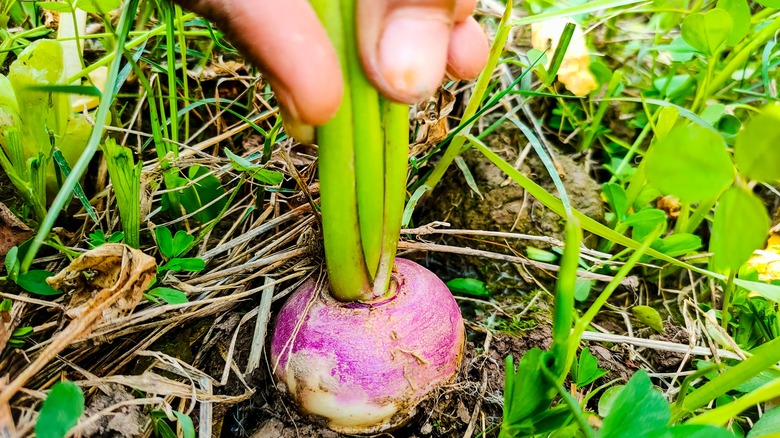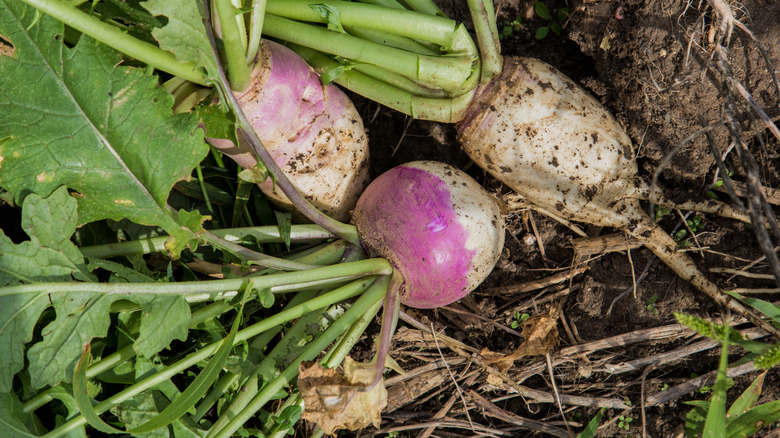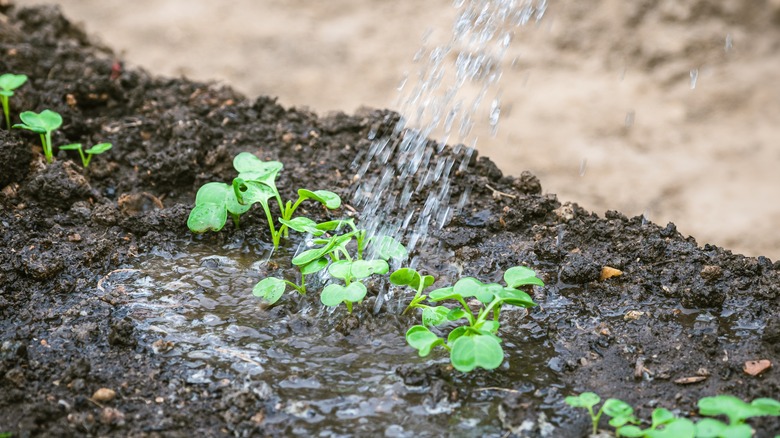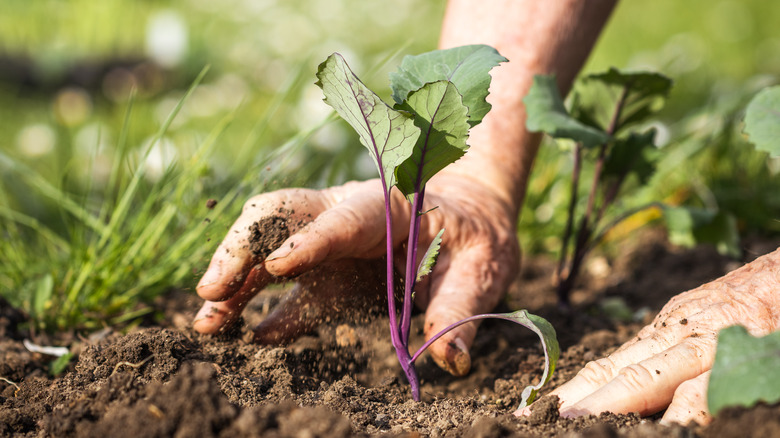Mistakes That Are Making It Harder For Your Turnips To Grow
For those who love the bite of a fresh turnip, growing them in your garden is an excellent, inexpensive way to have a large supply. Typically, turnips (Brassica rapa) are rather fast- and easy-growing root bulbs, but they do have a few requirements related to soil nutrient level, watering, and environmental conditions that could lead to a lack of development and are common mistakes growers make.
Though some varieties differ, many turnips can be harvested within a month or two after being sown. If you're growing from seed, it could take at least 40 days before you see a true turnip form. Usually, when the leaves reach about 6 inches in height, they are ready to harvest. Once you harvest them, you should have a larger-sized root, or bulb, to remove from the ground. A healthy turnip should have white flesh.
In some situations, the bulb may develop but may be more fibrous than desired. Other times, you may have limited growth at all. They can also grow large but lack flavor or be too tough to cook. All of these concerns shouldn't deter you from trying again, though. In many areas, completing a second planting of turnips in your garden may be possible. Before you do that, make sure you're not making one of these common mistakes that could be limiting your turnips from producing bulbs.
Make sure the soil has the right nutrient composition
Turnips are not difficult to grow if you create a healthy environment for them. This starts with the soil composition. These root vegetables do best in soil that's slightly acidic with a pH level of between 6 and 7.5. If you're not getting much growth at all from the plants, you may need to use a 10-10-10 fertilizer to help support better development.
If you have a significant amount of foliage growing, but the bulb itself is small or nonexistent, that could be a sign that there's too much nitrogen in the soil. That's good if you're growing turnips for the greens, but if you're after a nice turnip for salads or pickling, too much nitrogen can be problematic. This can happen if you've added a lot of fertilizer to the soil at the start of the year, organic or not. The best way to fix this problem is to give it time since water will reduce the levels present, reducing the risk for the next planting (either next fall or spring, depending on the time of the year).
The soil should also be well-drained and loose. They need loose or light soil so that their roots can develop into bulbs. If you have soil that's heavy in clay, consider mixing in some sand or other natural, lighter soil. Remove large rocks and break up any big chunks possible when planting turnips.
Water turnips enough, often more than you think
Another common problem is not watering turnips enough. Most root-based plants don't do well when there's too much water, but turnips need it. They tend to be very thirsty plants that like the soil to be kept highly moist or even wet most of the time. If the soil dries out, especially for a significant period, that will make it much less likely for the turnip to develop. Drought conditions are not likely to lead to significant tubular growth at all. If your turnip is more woody and has a bitter taste, that's because it lacks enough water throughout the growing period.
Aim for at least 1 inch of water a week, and keep the soil moist at all times. When you are watering them, water slowly and steadily for a few minutes to allow the water to penetrate into the soil (which hopefully is loose enough to allow for a good flow of water to the roots). This stimulates the roots to encourage growth. If you're not sure if you've watered long enough, take the time to dig into the ground nearby to see how deep you've watered. You need it to get several inches into the soil. Since turnips do best in areas of full sun or part shade, the soil can dry out quickly, putting the bulbs at risk if it lasts more than a day or so.
Give them the right start at the right time
Another big mistake when growing turnips is timing. You shouldn't try to grow them in the summer months as they don't tolerate heat well. Depending on the last frost date in your area, you can grow them in the early spring and then again in the fall, towards the end of summer. Turnips do best when the soil isn't too hot. If you have a plant that's gone to seed, but it didn't produce much of a bulb, that's likely because the soil was too hot.
To get the most out of the growing season, plant turnips a few weeks prior to the last likely frost date. The soil should be loose but still cool at this point. As the plant begins to grow and temperatures rise closer to summer, place a loose layer of leaves or other light mulch just under the foliage. That's going to help to create a small amount of shade to protect soil temperature and moisture levels. Once the cool fall air arrives, tilling the soil well will allow heat to be released. Then, you should be able to plant turnips again, and you may find it's much easier to get them to grow at this time of the year because of the lower temperatures. Good aeration of the soil can help to encourage healthy root development well into the fall. They are the ideal fall vegetable garden plant.



